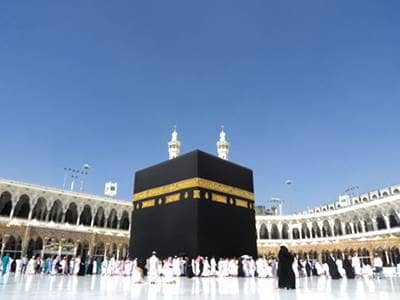
The so-called “Five Pillars of Islam” are the foundations and cornerstones -- or, as the term itself suggests, the “pillars” or supports – of Islamic faith and practice. All five are incumbent upon every physically and financially able Muslim:
(1) the recitation of the shahadah or creed (“There is no god but God [Allah], and Muhammad is his messenger”);
(2) formal prayers five times each day (at dawn, midday, midafternoon, sunset, and nightfall, always while facing Mecca);
(3) institutionalized charity to the poor (a percentage of one’s wealth [commonly 2.5%] is donated annually);
(4) the annual month-long fast during Ramadan (no food, no drink, no smoking, and no sex from dawn till dusk throughout the ninth month of the Islamic calendar); and
(5) the once-in-a-lifetime pilgrimage (Hajj) to the Islamic holy city of Mecca, in Saudi Arabia (during the twelfth month of the Islamic calendar, a month known as Dhu al-Hijjah).
Within Dhu al-Hijjah each year, the 8th to the 12th days of the month are dedicated to the annual Hajj (Arabic for “pilgrimage”). On the Western or Gregorian calendar this year, the upcoming Hajj period is estimated to coincide approximately with October 24 - 28, 2012.
During that time frame, approximately three million Muslims from all over the world will converge upon Mecca as pilgrims, fulfilling the fifth of Islam’s “Five Pillars” by participating in one of the world’s largest religious pilgrimages: the Hajj, or holy pilgrimage to Mecca.
The Hajj is not optional, but mandatory. As one of Islam’s “Five Pillars,” going on the pilgrimage to Mecca is a required religious duty, which must be performed at least once in the lifetime of every Muslim who is physically as well as financially able to do so.
As the birthplace and hometown of Muhammad, Mecca is Islam’s holiest city – so holy, in fact, that non-Muslims are not even permitted to enter. On the other hand, millions of Muslims from around the globe enter and crowd the city annually, temporarily tripling its population during the days of the Hajj.
This year, during the 8th to the 12th days of Dhu al-Hijjah, Muslim pilgrims (referred to as Hajjis) will arrive in Mecca and proceed to the Grand Mosque (the Masjid al-Haram, the largest and most sacred mosque in the world), which is large enough to accommodate up to four million pilgrims during the 2012 Hajj.
After preliminary purifications, and with men dressed only in sandals and two sheets of seamless white cloth (symbolizing equality before God), vast crowds of pilgrims will enter the immense central courtyard of the Grand Mosque. There, this vast sea of humanity will circle seven times around the Kaaba, the 43-foot-tall cube-shaped building that is the holiest site in Islam.
Built of granite, standing upon a marble base, and covered by a black silk curtain trimmed with gold, the Kaaba is the center of the Islamic universe. When Muslims around the world pray five times each day, every day, the direction they face during those ritual prayers is not just the direction of Mecca; it is the Kaaba itself to which they turn and face.
Muslims believe that Abraham (Ibrahim in the Quran) constructed the original Kaaba, around 2130 BCE; it has been frequently reconstructed over the centuries. Set in the eastern corner of the Kaaba is the Black Stone, an ancient stone (possibly meteoric) said to have fallen from heaven at the time of Adam and Eve, and installed in the Kaaba’s eastern corner by Abraham.
Crowds permitting, pilgrims today still attempt to kiss the Black Stone as they circumambulate counterclockwise seven times around the Kaaba (a procedure that, given the crowded conditions, can take several hours to complete).
After circumambulating the Kaaba seven times, pilgrims offer special prayers and then hurry back and forth seven times between two sacred hills, recalling Hagar’s desperate search for water for her son Ishmael (through whom Muslims trace their ancestral lineage back to Abraham). Pilgrims then drink water drawn a well an angel is said to have opened for Hagar.
About twelve miles outside of Mecca, pilgrims visit Mount Arafat for an afternoon of prayer, pious contemplation, and Quran recitation, near the site of Muhammad’s final sermon. This deeply reflective period is, in fact, regarded as the summit of the entire pilgrimage; no Hajj is considered complete without it.
At Mina (a few miles from Mecca), pilgrims ritually throw seven small stones or pebbles at three pillars, recalling Abraham’s act of defiantly throwing stones at the Devil, who thrice tempted him to refuse God’s command to sacrifice his son Ishmael (a famous test of faith in which the Bible specifies Isaac as the potential victim, rather than Ishmael as indicated by the Quran).
Animal sacrifices follow, reflecting God permitting Abraham to substitute a ram for his son. This launches the start of one of Islam’s two major festivals, Eid al-Adha (“Feast of Sacrifice”), from the 10th to the 12th of the month of Dhu al-Hijjah (approximately Oct 26 - 29, 2012).
Bringing to a festive conclusion the events of the annual Hajj period, Eid al-Adha is a four-day holiday celebrated not only in Mecca, but globally – by all Muslims, worldwide.
During these final days of the Hajj, pilgrims again circumambulate the Kaaba, and again throw pebbles at the pillars representing the Devil. Following the Hajj proper, pilgrims may optionally visit nearby Medina, the second holiest city in Islam (and the location of Muhammad’s tomb).
The subjective impact and personal spiritual significance of the Hajj is not to be underestimated or underappreciated. For Muslims, going on the Hajj is a profound, deeply moving, even life-changing experience.
Read more from Reed Hall at his Religion 101 Beliefnet blog!

